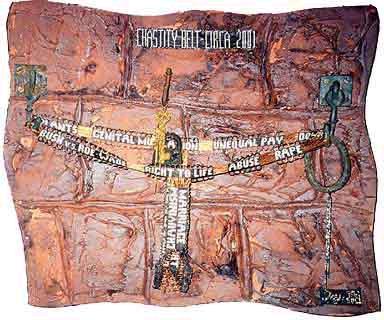The Board of Directors of the Brookings Arts Council in South Dakota has reconsidered its decision to exclude Joy Crane’s "Chastity Belt Circa 2001" from 25th Annual Juried Art Exhibit. Ms. Crane was recently invited to re-submit her work.
Background (posted July 27, 2001). Organizers of the Brookings Arts Council 25th Annual Juried Art Exhibit rejected Joy Crane’s "Chastity Belt Circa 2001" for fear it would not play well with the local community.
The Art Exhibit was open to all artists from the community to show their work. There were no content restrictions specified. Ms. Crane submitted her work following the procedures set by the Arts Council. However, one of the two pieces she submitted, "Chastity Belt," was not displayed. The artist was told her work was not included because it was deemed "not appropriate." In a conversation with NCAC, Sue Knutzen, President of the Brookings Arts Council, cited concern over the reactions of the local community as a reason to exclude the work.
The piece includes a beaded chastity belt bolted to what looks like a brick wall. On the belt are words and phrases including "Bush vs. Roe Wade," "Right to Life," "Equal Pay," "Abuse," "Rape" and "Genital Mutilation."
 |
As we insisted in our letter to Ms. Knutzen (jointly signed by NCAC, David Green of the First Amendment Project and Jennifer Ring of the ACLU of the Dakotas), randomly applying the vague and subjective standard of appropriateness to work that clearly constitutes protected speech raises serious constitutional concerns. The viewpoint expressed in "Chastity Belt" might well be unpopular and potentially controversial for Brookings, SD. But it is precisely to protect speech that is controversial or even offensive that the First Amendment exists. And, as the U.S. Supreme Court has affirmed: "If there is a bedrock principle of the First Amendment, it is that the government may not prohibit the expression of an idea simply because society finds the idea itself offensive or disagreeable." (Texas v. Johnson, 491 U.S. 397, 414, 1989)
Disenfranchised groups in this country have repeatedly expressed unpopular opinions and, as a result, have frequently affected public policy. There was a time, and not that long ago, when women had to fight for their access to information about contraception. In fact, the ideas expressed in Ms. Crane’s work are related to the ideas that inform feminist art from the 60s through today. It is, therefore, disturbing to find, in 21st century America, an arts council censoring expression referring to violence against women, to women’s rights to equal pay, to women’s rights over their bodies. Women have worked for the last 30 years to raise awareness of violence against women. Trying to silence women again?at this late date?is not constitutionally or morally acceptable. (On October 24, 2001, the National Association of Women Artists and NCAC are holding a panel discussion on women and censorship at the Freedom Forum in New York City. Check our web site for more details on that event.)
Ms. Knutzen insisted that the action of the Arts Council did not constitute censorship because the artist could still show her work in other venues. However, as legal precedents clearly show, the fact that the work can be shown in other venues does not at all mean that the Brookings Arts Council has not censored it. A very recent case from Washington State, Hopper v. City of Pasco, presents very similar situation. In that case the court firmly rejected the City’s argument that they were not censoring the artists as there were other places where their work could be shown. Here is an excerpt from the decision of the court:
Janette Hopper and Sharon Rupp are artists whose works were excluded from public display at the Pasco City Hall Gallery in Pasco, Washington, because city officials deemed their art too "controversial." The parties agree that the art is not obscene or pornographic. What made the City Hall Gallery the wrong place, the city contends, is the presence of employees, children, and citizens seeking to conduct their business with the city-and, of course, the city’s content-based conclusion that plaintiffs’ works were political, sexual, and controversial. The city steadfastly maintained that its exclusion of plaintiffs’ works was not "censorship" since Hopper and Rupp "have been free to show their art throughout the City,other than [at] city hall." The art, in Pasco’s view, was merely ejected from the parlor, not thrown off the farm. But relegating the art to the barnyard does not pass First Amendment scrutiny.
We do not endorse Pasco’s cramped view of what constitutes censorship, and we find none of the city’s reasons for excluding the art work compelling. Hopper v. City Of Pasco and Arts Council of The Mid-Columbia Region 241 F.3d 1067, 1081; 2001 U.S. App. LEXIS 2232 (9th Cir. 2001) (cert. filed June 7, 2001) (upholding claim that Pasco violated the artists’ First Amendment rights by excluding controversial art from city-sponsored exhibit) (emphasis added).
We hope that our intervention has helped the organizers understand the value of free expression?even when a work can potentially provoke negative responses from some community members. That art can occasionally make us think and discuss sensitive issues is not a bad thing at all. We commend the Brookings Art Council for reconsidering their decision in time so that the work could be displayed in the show before it closes.
For more information contact:
Svetlana Mintcheva, Arts Advocacy Coordinator
National Coalition Against Censorship
212/607-8222 x23

